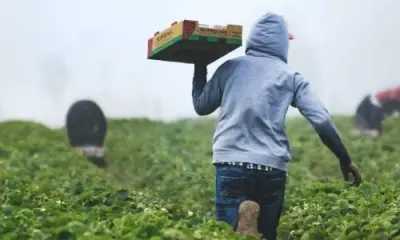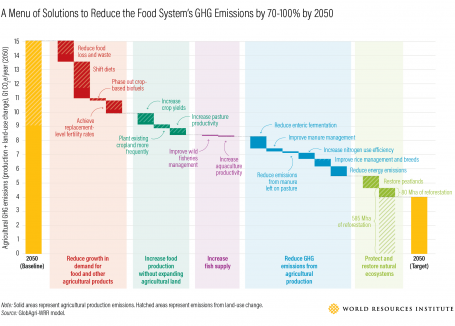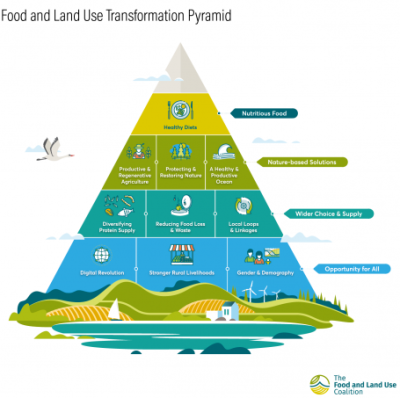The world faces a growing food systems crisis. The number of people who go to sleep hungry around the world grew by over 100 million in 2020. Obesity rates are up too, having tripled since 1975. Food supply chains continue to be disrupted by the COVID-19 pandemic and climate change — and commodity-driven deforestation remains a problem in many tropical forest-rich countries.

By Craig Hanson, Edward Davey, Liz Goodwin, Rebecca Carter, Sophie Wood and Janet Ranganathan
World Resources Institute
At the same time, the human quest for food is responsible for about a quarter of all global greenhouse gas emissions. That quest consumes more than 70% of all freshwater, is a major polluter of water and the leading driver of forest and biodiversity loss.
These crises are the reason for the UN Food Systems Summit, scheduled for September 2021 with a Pre-Summit happening at the end of July. It’s the first-of-its-kind opportunity for nations around the globe to tackle the question: How can we nutritiously feed a growing population amid worsening climate change while holding the line on further conversion of natural ecosystems, meeting the Paris Climate Agreement and lifting millions of farmers out of poverty?
Realizing the Full Potential of the Global Food System
A big part of the answer is that we need a cohesive plan for the food system to simultaneously produce, protect, reduce and restore. This strategy is laid out in WRI’s flagship World Resources Report, Creating a Sustainable Food Future.
- Produce: The world needs to sustainably boost yields on existing agricultural lands in order to meet projected growth in demand for food without expanding agriculture’s land footprint.
- Protect: The world needs to protect remaining native, natural ecosystems (e.g., forests, wetlands, grasslands) from agriculture-related conversion and degradation. These ecosystems store the majority of terrestrial carbon and provide critical ecosystem services that underpin food production such as water regulation, pollination and climate regulation.
- Reduce: The world needs to “bend the curve” in demand growth for land-intensive products by reducing existing inefficiencies in the food system, such as by halving the rate of food loss and waste by 2030, shifting to more sustainable and healthy diets, and reducing competition for land and food from other sectors such as biofuel production.
- Restore: The world needs to restore what’s been lost — revitalizing nature in some places and restoring productivity to degraded agriculture in other places.
The “produce, protect, reduce and restore” approach can nutritiously feed nearly 10 billion people by 2050 and help lift poor farmers out of poverty, while putting food and land use systems on a path to compliance with the mitigation goals of the Paris Agreement on climate change.

At the same time, farmers and herders, particularly those most vulnerable to climate and other types of shocks and stresses, will need additional support to adapt to climate change impacts (read more in Adapt Now, the flagship report of the Global Commission on Adaptation, and the report Food Systems at Risk). Often, it’s smallholder farmers who live and work on the front lines of climate change impacts who have the fewest resources with which to adapt.
It is essential to ensure that the world’s 500 million small-scale food producers are not left behind as inequality gaps widen in part due to worsening climate change. These farm workers need help increasing their productivity while also managing increased climate risks by diversifying their incomes, strengthened social security systems and improved access to insurance and finance.
In addition, particular attention must be given to enhancing rights and access to resources for women and young people involved in food production, as they are an important and growing force in the future of the food system. Dedicated attention, funding and programs are needed for areas that will need to produce entirely new types of crops and livestock better suited to changing climates, or even transition out of agriculture entirely.
All of this requires, among other things, innovation, investment andinclusion. For instance, a number of breakthrough technology innovations can play a role. An estimated $300 billion to $350 billion in investment is needed to scale change in food systems. And everyone, ranging from smallholder farmers to food companies to individual consumers, needs to be included in the decisions, actions and benefits of a better food system. Altogether, creating a sustainable food system requires a suite of critical transitions that span food supply, food demand and human well-being.
The Critical Role of the Food Systems Summit

It is important that the Food Systems Summit advance this framework for a better, more sustainable and equitable food system.
Although not an exhaustive list, a few areas worthy of an added “push” by the summit include:
- Increase National Ambition: Every nation in the world must do more to bring together ministries of finance, health, trade, agriculture and environment to achieve ambitious action in the food system. More than 130 countries have participated in national Food Systems Summit dialogues to this end. It’s now up to heads of state to step forward at the formal summit in September with ambitious, time-bound, national commitments that encompass climate, hunger, nutrition, equity, livelihoods and diets.
- Cut Food Loss and Waste in Half by 2030: Tackling the more than one billion tons of food that’s lost or wasted between farm and fork every year is vital if countries are to end hunger and meet climate targets. The summit is an opportunity for national governments, as well as businesses and other players, to prioritize the problem of food loss and waste by adopting the “Target, Measure, Act” approach: set a 50% reduction target, measure to identify hotspots of food loss and waste, and act on the hotspots.
- Champion “Blue Food” Solutions: Aquatic or “blue” foods (including animals, plants and microorganisms) from marine and inland waters contribute significantly to healthy, nature-positive and resilient food systems and have the potential to do far more to help end malnutrition and support dignified work. Still, those “blue” foods are often missing from conversations about food systems. Systems-level change is needed to enable “blue food solutions,” which can include integrating aquatic foods into national food policy and school feeding programs, and supporting small-scale fishers and sustainable aquaculturists. Several international agreements are already in place to achieve these changes, but urgent action and investments to step up the pace of implementation are needed.
- Mobilize Agricultural Research, Finance and Information for Small-scale Food Producers to Build Resilience and Enhance Incomes: This includes doubling the scale of agricultural research around the world, including through the CGIAR System as it fully embeds climate change in every aspect of its new 10-year strategy. It also means expanding access to climate-informed digital advisory services with enhanced information on weather and seasonal forecasts, pest and disease early warning, digital soil maps and adaptive production practices. Small-scale food producers’ access to insurance, finance, markets, adaptive technologies and agroecological practices must also be expanded to effectively build resilience.
Success requires strong engagement from nations to companies to farmers to consumers. With the summit’s global focus on the entire food system, the world has the opportunity to create change at the scale needed. If we miss the opportunity, the consequences may be dire. But if we successfully seize it, the world can achieve a more sustainable food future.
(Originally appeared at the World Resources Institute website)



